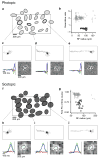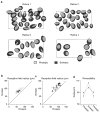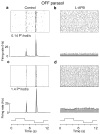High-sensitivity rod photoreceptor input to the blue-yellow color opponent pathway in macaque retina
- PMID: 19668201
- PMCID: PMC2789108
- DOI: 10.1038/nn.2353
High-sensitivity rod photoreceptor input to the blue-yellow color opponent pathway in macaque retina
Abstract
Small bistratified cells (SBCs) in the primate retina carry a major blue-yellow opponent signal to the brain. We found that SBCs also carry signals from rod photoreceptors, with the same sign as S cone input. SBCs exhibited robust responses under low scotopic conditions. Physiological and anatomical experiments indicated that this rod input arose from the AII amacrine cell-mediated rod pathway. Rod and cone signals were both present in SBCs at mesopic light levels. These findings have three implications. First, more retinal circuits may multiplex rod and cone signals than were previously thought to, efficiently exploiting the limited number of optic nerve fibers. Second, signals from AII amacrine cells may diverge to most or all of the approximately 20 retinal ganglion cell types in the peripheral primate retina. Third, rod input to SBCs may be the substrate for behavioral biases toward perception of blue at mesopic light levels.
Figures






References
-
- Masland R. The fundamental plan of the retina. Nat Neurosci. 2001;4:877–886. - PubMed
-
- Dacey D. Origins of perception: retinal ganglion cell diversity and the creation of parallel visual pathways. In: Gazzaniga M, editor. The Cognitive Neurosciences. MIT Press; 2004. pp. 281–301.
-
- Field G, Chichilnisky E. Information processing in the primate retina: circuitry and coding. Annu Rev Neurosci. 2007;30:1–30. - PubMed
-
- Dacey D, Lee B. The ’blue-on’ opponent pathway in primate retina originates from a distinct bistratified ganglion cell type. Nature. 1994;367:731–735. - PubMed
-
- Szmajda B, Grunert U, Martin P. Retinal ganglion cell inputs to the koniocellular pathway. J Comp Neurol. 2008;510:251–268. - PubMed
Publication types
MeSH terms
Substances
Grants and funding
LinkOut - more resources
Full Text Sources
Miscellaneous

